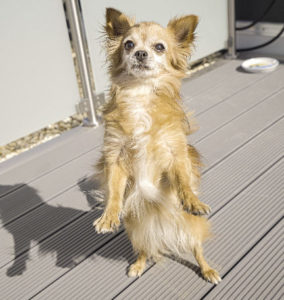Your dog learns nothing if you’re always telling them what to do. You need to turn that around and teach, don’t tell, your dog.
As an example, the most common dog issue we address every single class is dogs jumping up on people. Every time a dog jumps on someone, the dog’s owner tells the dog “off” or “down” and pulls on the dog to make that happen. If the dog’s on leash, they pull on the leash. Wearing a collar? They pull on the collar. If the dog’s naked, they grab the dog’s legs or shoulders to make it happen.
Stop doing that. For two reasons:
- It doesn’t work. Witness the fact that you have to keep doing it.
- It teaches your dog nothing. Evidenced by the fact that your dog’s still doing it.
If you need more convincing that your current practice isn’t helping, try looking up Einstein’s definition of insanity. If you always do what you’ve always done, you’ll always get what you always got.
Do this instead
It’s hard to teach any dog what “not” to do. Instead, give your dog an alternate greeting behavior that everyone will enjoy. How about you teach your dog to “Sit!” to say hello?

Set up the situation by enlisting the help of a friend who won’t mind, and won’t get hurt, if your dog does jump on them. Arrange a time and place that your friend will come to your house or meet you. Have your dog on leash and as your friend arrives, tell your dog to “Sit!” Your friend comes over to you and your sitting dog. Both of you give treats, praise, and pets to your dog as long as they’re sitting. If the dog gets up or jumps on the friend, both of you immediately disengage with the dog, stay quiet, fold your arms across your chest, and stare at the ceiling.
Your dog won’t know what’s happening at first. They may keep jumping, or nudging at either or both of you. Ignore it. Don’t say anything. Your dog may act a fool for a bit. That’s okay. Just wait. Sooner or later, your dog will figure out what was working and try it again. As soon as the dog is sitting, both of you praise, pet, and reward the dog. Make a big fuss for good behavior. Repeat as needed.
Hold up your end of the bargain
Depending on the dog and the people, and how long the behavior’s been entrenched, it may take a few sessions to get the message across. Letting your dog think it through is the way to teach them, rather than tell them, how to act.
All dog training is negotiating with your dog. They get what they want (attention) when you get what you want (polite behavior). Dogs aren’t picky about the kind of attention they get. Dogs don’t distinguish between positive attention (praise, rewards, pets) and negative attention (shouting, corrections, punishment). As long as you’re paying attention to them, they’re happy. Pulling on them, yelling at them, kneeing them in the chest is all attention. That stops the behavior for the moment. But it’s a very temporary fix.
Take it out for a ride
It won’t really take long for your dog to get in the habit of “Sit To Greet!” for you and your friend. When your dog is successful most of the time, change the friend you practice with. Or change the place you’re practicing. Go to the friend’s house, or a different friend’s house. Let your dog know that the same behavior is good wherever you are, whoever you’re meeting.
When you think your dog’s understanding is pretty solid, go someplace you can recruit a couple dog-friendly strangers to reward your dog for polite behavior. Go to a pet shop, veterinarian’s office, grooming shop, or any dog-friendly place. When you ask people to help, explain what you’re up to and what you expect your dog to do. With our own dogs we’ve even set ourselves up outside a nearby commuter train station. In that situation, look for people not hurrying, who smile at your cute dog. Those are the ones most likely to help.
Just ask one or two people, then call it a day. You don’t want to overload your dog. This kind of exercise, especially with strangers, can be stressful, stimulating, and exhausting for your dog. Having to think and control their impulses is hard work. You can judge how your dog is doing with a small sample. It takes a while for the taught behavior to become your dog’s first response. Give them time to get it right.
It will happen
Most of the dogs in our “Manners” classes jump on people at the start. And we offer ourselves as the “friendly stranger” every week. The first week, all the dogs jump on us and it takes a while. The second week, there’s usually an initial jump followed fairly quickly by a “Sit!” The third week, most dogs sit as soon as we head in their direction.
What actually takes the most practice is getting the people to be quiet and stop physically manipulating their dogs. Common courtesy demands that we don’t let our dogs jump on other people. But in this case, we have to put politeness aside and let them be rude. When rudeness doesn’t work, the dogs engage their brains and try something else. So, we’ve seen that it doesn’t work if we just tell our dogs what to do. Teach, don’t tell, your dog.







